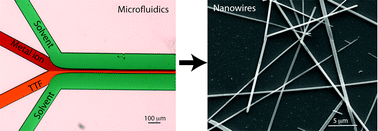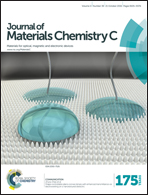Conductive single nanowires formed and analysed on microfluidic devices†
Abstract
In this work, we studied the formation of fibres and particles made of metal salts and derivatives of tetrathiafulvalene (TTF) on a microfluidic device and in a conventional reaction flask, and characterized their morphologies, optical properties and electrical conductivities. A series of uniform one-dimensional (1D) structures were successfully formed via charge transfer interactions at the interface of two laminar streams on the microdevice. In general, these structures were significantly thinner and longer than those obtained in the standard bulk approach. The reaction between metal ions and different TTF derivatives indicated that the high planarity and strong molecular interaction of TTF derivatives are beneficial for nanowire formation. The conductivities of these metal-tetrathiafulvalene (M-TTF) and metal-formyl-tetrathiafulvalene (M-FTTF) nanowires were in the range of 10−1 to 101 S cm−1 at room temperature, being one to two orders of magnitude greater than those of metal-bis(ethylenedithio)tetrathiafulvalene (M-BEDT-TTF) (4.8 × 10−3 to 1.2 × 10−2 S cm−1 at room temperature). However, not all combinations of metal salts and TTF derivatives yielded fibres. In many cases, we obtained particles or dendritic structures both in bulk reactions and on the microdevice. Hence, our study provides a comprehensive overview of the morphologies of the products obtained from reactions of metal salts and TTF including different commercially available derivatives.


 Please wait while we load your content...
Please wait while we load your content...